What role this doctor–patient conversation dataset play in EHR voice input automation?
Speech Recognition
Healthcare
EHR Automation
The Doctor–Patient Conversation Speech Dataset is a crucial component in advancing Electronic Health Record (EHR) voice input automation. By providing realistic, nuanced dialogue data, it enhances the performance of voice recognition technologies in healthcare, ensuring accurate and efficient transcription of medical interactions.
How This Dataset Powers EHR Voice Recognition
This dataset comprises unscripted conversations between doctors and patients, closely mirroring real clinical dialogues. Its authenticity is key for training speech recognition systems that need to accurately capture and transcribe complex medical conversations. Here's how it contributes to EHR voice input automation:
- Training Advanced Speech Recognition Models
- The dataset aids in developing Automatic Speech Recognition (ASR) models that can transcribe spoken language into text with high accuracy. It includes diverse medical dialogues, helping models recognize terminology across various specialties and adapt to different accents and speech patterns.
- Enhancing Natural Language Understanding (NLU)
- Beyond transcription, EHR systems require a grasp of intent and context. The dataset's rich speech annotation enables systems to identify symptoms, medications, and patient sentiments, essential for precise clinical documentation.
- Improving User Experience
- Familiar and intuitive interactions are crucial for user adoption of voice input systems. By using real-world conversations, the dataset ensures that these systems integrate seamlessly into clinical workflows, enhancing user engagement.
Significance of Realistic Conversations
Why is the realism of this dataset so important? In healthcare, the nuances of conversation—such as a doctor's questioning style or a patient's expression of concern—are critical for accurate understanding and transcription. Traditional scripted datasets often miss these subtleties, leading to comprehension gaps. In contrast, this dataset captures the range of interactions, including consultations and follow-ups, with all their tones, pauses, and emotional undertones—elements vital for developing effective EHR systems.
Challenges and Best Practices
Deploying EHR voice input automation using this dataset comes with its own set of challenges. Here are key considerations:
- Balancing Data Diversity and Complexity
- While a diverse range of dialogues is beneficial, it can introduce complexity in model training, especially with multiple languages and accents. Achieving a balance is essential for maintaining high voice recognition accuracy.
- Ensuring Annotation Quality
- The dataset's effectiveness hinges on the quality of its annotations. Consistent and accurate tagging of medical terms and intents is crucial for training robust NLU models.
- Seamless Technological Integration
- Integrating voice input automation into existing systems requires careful consideration of the technology stack to ensure insights from the dataset are leveraged without adding complexity for users.
Avoiding Common Pitfalls
Even experienced teams may misjudge the potential of this dataset. Common missteps include:
- Underestimating Realism's Importance
- Assuming any voice data will suffice can lead to poor performance. The unique nuances captured in this dataset are vital for systems that truly understand healthcare dialogues.
- Neglecting Continuous Feedback Loops
- Failing to gather user feedback post-deployment can hinder ongoing improvement. Continuous training with fresh data, including user interactions, is essential for refining ASR and NLU models.
- Inadequate Testing Across Real-World Scenarios
- Testing systems only under ideal conditions can be misleading. Simulating real-world variations, such as background noise or emotional stress, is necessary to ensure robustness.
Real-World Impact and Next Steps
The Doctor–Patient Conversation Speech Dataset is a pivotal asset for EHR voice input automation, offering realistic content and linguistic diversity that empowers developers to create systems that accurately transcribe and understand healthcare conversations. By focusing on realism, investing in quality annotations, and maintaining vigilance about user feedback, teams can leverage this dataset to build next-generation healthcare solutions that improve efficiency and patient care.
For EHR projects requiring advanced voice recognition, FutureBeeAI's Doctor–Patient Conversation Speech Dataset offers a comprehensive solution, ready to support your healthcare AI initiatives with unparalleled realism and linguistic diversity.
FAQs
Q. What makes this dataset particularly valuable for EHR systems?
Its unscripted, authentic conversations across multiple medical specialties and languages provide the necessary context and nuance for training effective ASR and NLU models, crucial for EHR automation.
Q. How can teams optimize the use of this dataset in EHR systems?
Focusing on high-quality annotations, integrating continuous user feedback, and thoroughly testing in real-world scenarios will help maximize the dataset's potential and improve EHR voice input systems.
What Else Do People Ask?
Related AI Articles
Browse Matching Datasets
Acquiring high-quality AI datasets has never been easier!!!
Get in touch with our AI data expert now!




-data-collection/thumbnails/card-thumbnail/top-resources-to-gather-speech-data-for-speech-recognition-model-building.webp)



